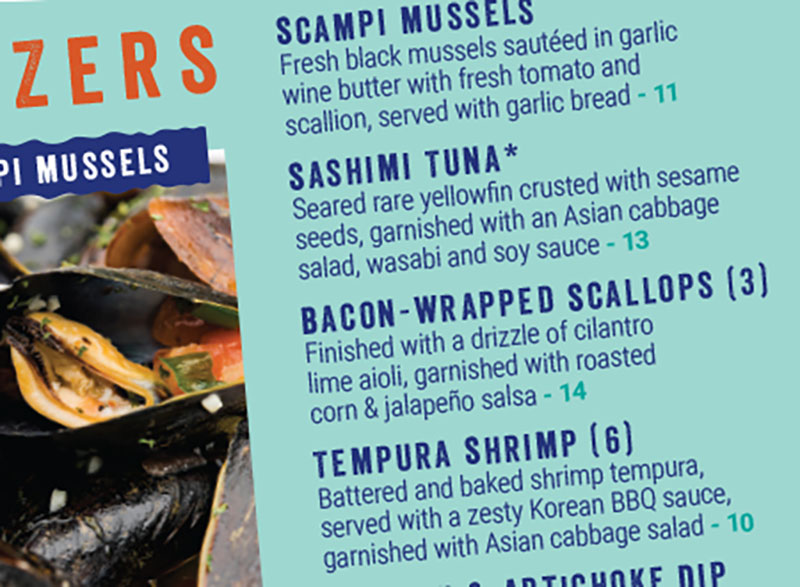
Menu Descriptions That Sell
Using Words To Make Mouths Water
A great meal starts long before the first bite. It begins with the way a dish is described. When guests read your menu, your words should do more than list ingredients. They should spark the senses, helping customers imagine the taste, smell, and texture of every dish. That’s the power of a great menu description.
In today’s competitive restaurant industry, every word matters. A plain list of ingredients won’t inspire anyone, but vivid descriptions that paint a picture make guests feel like they’re already tasting the dish. It’s one of the easiest and most powerful ways to elevate your restaurant marketing and boost your menu sales.
WHY GREAT DESCRIPTIONS MATTER
Research shows that well-written menu descriptions can increase sales by as much as 30 percent. Descriptive language helps guests visualize their meal, triggering the senses and building anticipation. Think about it: “grilled chicken with vegetables” sounds plain, but “herb-marinated grilled chicken served with fire-roasted vegetables and garlic butter” practically lets you taste it.
A strong menu description adds perceived value to the dish and makes guests feel more comfortable paying a higher price. It sets clear expectations, builds trust, and creates an emotional connection between your guests and your brand.
HOW TO WRITE MENU DESCRIPTIONS THAT SELL
Here are some practical ways to transform plain menu descriptions into irresistible ones:
- APPETIZER FLIGHTS: Words like crisp, tender, juicy, or creamy help guests imagine each bite.
- TELL A SHORT STORY: Share where ingredients come from or what inspired the recipe. For example, “Our homemade marinara sauce starts with sun-ripened tomatoes and fresh basil picked from local farms.”
- HIGHLIGHT CRAFTSMANSHIP: Terms like “house-made,” “wood-fired,” or “slow-cooked” add authenticity and elevate dishes.
- KEEP IT CONCISE: Descriptions don’t need to be long to be effective. Focus on words that add flavor, not filler.
- MATCH YOUR BRAND VOICE: A casual restaurant can be playful, while fine-dining should feel refined. Keep your tone consistent with your brand personality.
USING DESCRIPTIONS STRATEGICALLY
Menu descriptions can do more than sound appealing. They can guide guests toward certain dishes, increasing your average check size.
- FEATURE YOUR SIGNATURE ITEMS: Give your best dishes the spotlight with stronger, more detailed descriptions to capture attention.
- POSITION HIGHER-MARGIN DISHES STRATEGICALLY: Place them where eyes naturally land, near the top or bottom of a section.
- HIGHLIGHT PREMIUM INGREDIENTS: Mentioning premium ingredients help justify pricing and adds perceived value.
- KEEP IT FRESH: Refreshing your menu content can reignite interest in familiar dishes and make your offerings feel new again.
When done well, menu descriptions not only increase sales but also create lasting impressions. Guests are far more likely to remember a meal that engaged their senses from the moment they opened the menu.
COMMON MISTAKES TO AVOID
- SKIP GENERIC WORDS: Phrases like “tasty” or “delicious” don’t say much. Show flavor through vivid details instead.
- AVOID CONFUSING JARGON: Overly technical terms or chef-speak might sound impressive, but if guests don’t understand them, they are more likely to skip the dish. Keep your language simple, inviting, and appetizing.
- KEEP THE LAYOUT CLEAN: Long paragraphs or cluttered designs make menus harder to read and less engaging.
- BE HONEST: Exaggeration can break trust. Authentic, accurate descriptions build credibility.
FINAL THOUGHTS
Writing menu descriptions that sell is about telling a story that stirs the senses and entices appetites. When your descriptions help guests see, smell, and taste the dish in their minds, the menu transforms into an experience. By using thoughtful, sensory-driven language, you give guests a taste of what makes your restaurant special before their plate ever reaches the table.
So, the next time you update your menu, take a closer look at your descriptions and ask yourself, “Would I be tempted to order this?” If the answer is yes, your menu is doing its job.
